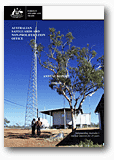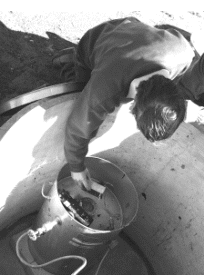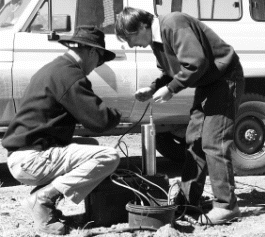


Annual Report 1998-99 |
 |
PROGRAM ACTIVITIES
ASNO’s activities in 1998–99 are described and evaluated in the following sections.
Activities are described in relation to particular tasks, and grouped according to the output to which they relate (see summary of outcomes and outputs).
OUTPUT E
Operation of the national authority for implementation of the CTBT, including development of CTBT verification systems and development of arrangements in support of Australia’s CTBT commitments.
Milestone E1
E1.1 Operate effectively as the national point of liaison with the CTBTO and other States in relation to the fulfilment of Australia’s obligations under the CTBT.
E1.2 Facilitation and enhancement of Australia’s technical contributions to the work of the Preparatory Commission and its working groups.
Activities
The Australian Comprehensive Test-Ban Office (ACTBO—now part of ASNO) commenced activities in July 1998 and was designated as Australia’s national authority for the CTBT shortly thereafter in advice to the Executive Secretary of the Preparatory Commission. As the CTBT and Australia’s implementing legislation are not yet in force, ASNO does not currently carry out the full range of national authority functions, but is making preparations to do so.
Important initial steps in these preparations have been for ASNO to establish and develop contacts with the CTBTO’s Provisional Technical Secretariat (PTS) and with Australian governments, agencies and institutions with a stake in CTBT activities, especially the development of the IMS (Annex H lists the proposed Australian IMS stations).
ASNO has managed the process through which Australia’s agreement is given to the conduct of site surveys and establishment or upgrade of IMS stations. During the year ASNO has confirmed Australia’s acceptance of a number of PTS activities - advice being passed to the PTS in letters between the Executive Secretary of the CTBTO Preparatory Commission and the Australian Ambassador in Vienna.
Also, ASNO coordinated Australia’s views on the establishment of a communications infrastructure for transmission of data from IMS stations to the CTBT International Data Centre (IDC) in Vienna.
Australia is widely regarded as making a vital contribution to the development of the CTBT and the IMS. ASNO officers took part in technical working group sessions in Vienna in February and May 1999, and work closely with Australia’s technical specialists who contribute regularly to the work of this group.
 |
|
|
Performance Assessment
ASNO has developed effective liaison for communication and consultation with stakeholders in the IMS development process.
Australia’s acceptance of the following PTS activities was confirmed by ASNO after consultations with stakeholders:
- site survey of infrasound monitoring stations at Hobart and Narrogin, WA;
- upgrade of the primary seismic monitoring station at Stephens Creek in NSW;
- establishment of a hydroacoustic array off Cape Leeuwin;
- establishment of radionuclide monitoring stations in Melbourne, Perth, Townsville and Darwin; and
- upgrading of infrasound monitoring at Warramunga in the NT
Arrangements for the transmission of IMS data from Australia’s IMS stations have been agreed with the PTS, consistent with relevant national interests.
Although the number of national authorities designated under the CTBT is still small, ASNO, as Australia’s national authority, has provided a good interface between technical and policy specialists.
Milestone E2
Timely establishment and maintenance of legal and administrative mechanisms which will give effect to CTBT obligations in Australia.
 |
|
Photograph courtesy of the ANU |
Activities
The Comprehensive Nuclear Test-Ban Treaty Act 1998 received Royal Assent on 2 July 1998. However, section 2 of the Act provides that it will not come into force before the day the CTBT enters into forcewhich will occur 180 days after the Treaty has been ratified by 44 named States. At 30 June 1999, 38 States had deposited an instrument of ratification, including 19 of the named 44.
The CTBTO’s Provisional Technical Secretariat (PTS) manages the development of the IMS internationally and funds the upgrade or establishment of stations from the contributions of CTBT signatories. To facilitate the work of the PTS, each signatory should negotiate and put in place a facility agreement or arrangement to set out procedures for the conduct of PTS activities, and to provide the PTS with appropriate privileges and immunities. Australian Government authorisation for PTS activities has, to date, been given through exchanges of letters with the CTBTO’s Preparatory Commission (PrepCom), but should in future be effected through a facility arrangement. In coordination with other Australian stakeholders ASNO has developed the Australian position for exchanges with the PTS.
Consistent with principles set out in the CTBT, activities associated with the development of its verification are funded primarily from the contributions of signatories. This includes training of people involved with the work of the Treaty. ASNO coordinates the involvement of Australians in this training. During the year, five Australians took part in training for future responsibilities as station operators, or as inspectors to be deployed should the Treaty’s On-Site Inspection provisions be invoked (because of serious concerns about compliance).
Performance Assessment
As entry into force of the CTBT is still some time off, preparation of legislation and administrative measures subsidiary to the Act has not been a high priority for ASNO during 1998–99.
Negotiation of a facility arrangement with the CTBT PrepCom has now been advanced to a point where all issues have been agreed, except those relating to provision of tax immunities for the PTS.
The training and experience, gained both in Australia and overseas, that has accompanied development and maintenance of the CTBT’s verification mechanism has provided ASNO with excellent opportunities to nurture and sustain a sound base of expertise in nuclear monitoring issues.
Milestone E3
Effective coordination of the establishment and operation of IMS stations in Australia.
Activities
With 20 monitoring stations and one radionuclide laboratory, Australia will have the third largest number of IMS facilities of any country. Stakeholders in the development and maintenance of these facilities include companies or institutions engaged in the construction or upgrading of IMS stations, current and future facility operators, relevant State and Territory governments and Commonwealth agencies, and the CTBT Organisation. The key part of ASNO’s CTBT activities is liaison with these stakeholders to ensure timely and efficient development of IMS facilities in Australia. Thus:
- Through frequent contacts, ASNO has developed a strong working relationship with the agencies and institutions carrying out work surveying and establishing, or upgrading, Australian IMS facilities.
- Governments of States and Territories have been consulted on the development of IMS facilities within their jurisdiction. A paper updating States and Territories on progress overall was provided to them through the Standing Committee on Treaties in April 1999. Individual Premier’s Departments were consulted directly as required.
- Liaison with the CTBTO’s Provisional Technical Secretariat (PTS) has been developed during visits by ASNO officers to Vienna, but is usually effected through tasking of Australia’s Embassy in Vienna.
- Where a new IMS station is to be established, environment protection and other land use requirements that may need to be addressed have been identified. A particular task during the latter part of 1998–99 has been to guide the development of proposals for the Cape Leeuwin hydroacoustic station, in coordination with the Western Australian Government and with Commonwealth agencies, so that these requirements will be met.
Performance Assessment
Significant IMS developments during the year were:
- completion of upgrade activities at the Warramunga seismic array, NT—work was carried out by the Australian National University (ANU);
- completion of site survey and negotiation of contracts for installation of an infrasound monitoring facility at Warramunga—work was carried out by the ANU;
- finalisation of site surveys and commencement of activities for installation of radionuclide monitoring stations at Melbourne and Perth, and site survey for a station on the Cocos Islands—work is being carried out by ARPANSA;
- finalisation of contracts for upgrade of the primary seismic station at Stephens Creek in New South Wales—work will be carried out by the Australian Geological Survey Organisation (AGSO); and
- completion of site survey work and issue of request for proposals for installation of the hydroacoustic monitoring station at Cape Leeuwin—work was carried out by CSIRO under contract to the PTS.
Milestone E4
In coordination with other areas within DFAT, provide useful and timely guidance to Australian diplomatic posts on IMS and other verification related issues of interest to Australia.
Activities
Day-to-day liaison with the CTBTO-PTS is carried out through Australia’s Embassy in Vienna, and ASNO has provided advice and tasking for this activity during the year in relation to IMS issues, and those affecting Australian stations in particular.
Briefing to the Minister on CTBT during 1998–99 has been limited to contributions to regular reporting by DFAT.
Performance Assessment
Liaison with Australia’s Vienna Embassy on CTBT matters during the year has been timely and has enabled it to interact effectively with the PTS. ASNO, in conjunction with DFAT, ARPANSA and AGSO, has prepared guidance and tasking on the full range of verification related issues.